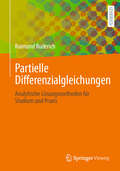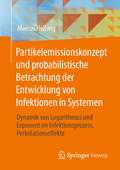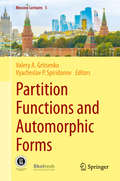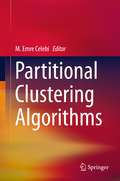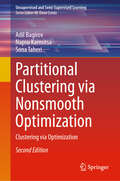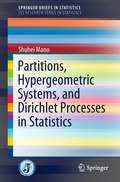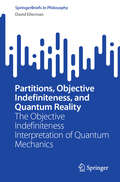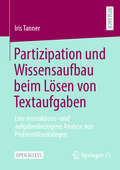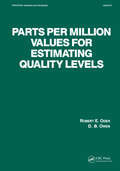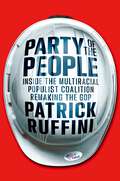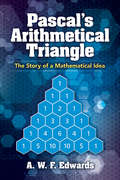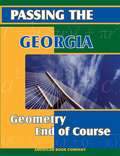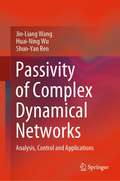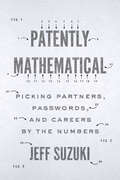- Table View
- List View
Partielle Differenzialgleichungen: Analytische Lösungsmethoden für Studium und Praxis
by Raimund RuderichDieses Lehrbuch vermittelt das Grundwissen der verschiedenen analytischen Lösungsmethoden partieller Differenzialgleichungen. Zur jeder Methode werden Beispiele detailgenau durchgerechnet, die mit einfachen Erklärungen für Klarheit sorgen. Studierende lernen zielgerichtet diejenige Methode auszuwählen, die am besten zur Problemstellung passt. Als Unterstützung werden Hinweise zum kostenlosen internetbasierten CAS (Computer-Algebra-System) "WolframAlpha" bereitgestellt.
Partikelemissionskonzept und probabilistische Betrachtung der Entwicklung von Infektionen in Systemen: Dynamik von Logarithmus und Exponent im Infektionsprozess, Perkolationseffekte
by Marcus HellwigDas Buch beschreibt die Möglichkeit, eine probabilistische Prognose zu erstellen, die den mittleren n-Tage-Logarithmus von Fallzahlen in der Vergangenheit verwendet, um einen Exponenten für eine Wahrscheinlichkeitsdichte für eine Prognose zu bestimmen, als auch das Partikelemissionskonzept, das sich herleitet aus Kontakt- und Verteilungsrate, welche den Exponenten der voraussichtlichen Entwicklung in dem Maß erhöht wie sich eine Gruppenbildung von Personen bilden kann.
Partition Functions and Automorphic Forms (Moscow Lectures #5)
by Valery A. Gritsenko Vyacheslav P. SpiridonovThis book offers an introduction to the research in several recently discovered and actively developing mathematical and mathematical physics areas. It focuses on: 1) Feynman integrals and modular functions, 2) hyperbolic and Lorentzian Kac-Moody algebras, related automorphic forms and applications to quantum gravity, 3) superconformal indices and elliptic hypergeometric integrals, related instanton partition functions, 4) moonshine, its arithmetic aspects, Jacobi forms, elliptic genus, and string theory, and 5) theory and applications of the elliptic Painleve equation, and aspects of Painleve equations in quantum field theories. All the topics covered are related to various partition functions emerging in different supersymmetric and ordinary quantum field theories in curved space-times of different (d=2,3,…,6) dimensions. Presenting multidisciplinary methods (localization, Borcherds products, theory of special functions, Cremona maps, etc) for treating a range of partition functions, the book is intended for graduate students and young postdocs interested in the interaction between quantum field theory and mathematics related to automorphic forms, representation theory, number theory and geometry, and mirror symmetry.
Partitional Clustering Algorithms
by M. Emre CelebiThis book focuses on partitional clustering algorithms, which are commonly used in engineering and computer scientific applications. The goal of this volume is to summarize the state-of-the-art in partitional clustering. The book includes such topics as center-based clustering, competitive learning clustering and density-based clustering. Each chapter is contributed by a leading expert in the field.
Partitional Clustering via Nonsmooth Optimization: Clustering via Optimization (Unsupervised and Semi-Supervised Learning)
by Adil Bagirov Napsu Karmitsa Sona TaheriThis updated book describes optimization models of clustering problems and clustering algorithms based on optimization techniques, including their implementation, evaluation, and applications. The book gives a comprehensive and detailed description of optimization approaches for solving clustering problems; the authors' emphasis on clustering algorithms is based on deterministic methods of optimization. The book also includes results on real-time clustering algorithms based on optimization techniques, addresses implementation issues of these clustering algorithms, and discusses new challenges arising from very large data and data with noise and outliers. The book is ideal for anyone teaching or learning clustering algorithms. It provides an accessible introduction to the field and it is well suited for practitioners already familiar with the basics of optimization.
Partitions, Hypergeometric Systems, and Dirichlet Processes in Statistics (SpringerBriefs in Statistics #0)
by Shuhei ManoThis book focuses on statistical inferences related to various combinatorial stochastic processes. Specifically, it discusses the intersection of three subjects that are generally studied independently of each other: partitions, hypergeometric systems, and Dirichlet processes. The Gibbs partition is a family of measures on integer partition, and several prior processes, such as the Dirichlet process, naturally appear in connection with infinite exchangeable Gibbs partitions. Examples include the distribution on a contingency table with fixed marginal sums and the conditional distribution of Gibbs partition given the length. The A-hypergeometric distribution is a class of discrete exponential families and appears as the conditional distribution of a multinomial sample from log-affine models. The normalizing constant is the A-hypergeometric polynomial, which is a solution of a system of linear differential equations of multiple variables determined by a matrix A, called A-hypergeometric system. The book presents inference methods based on the algebraic nature of the A-hypergeometric system, and introduces the holonomic gradient methods, which numerically solve holonomic systems without combinatorial enumeration, to compute the normalizing constant. Furher, it discusses Markov chain Monte Carlo and direct samplers from A-hypergeometric distribution, as well as the maximum likelihood estimation of the A-hypergeometric distribution of two-row matrix using properties of polytopes and information geometry. The topics discussed are simple problems, but the interdisciplinary approach of this book appeals to a wide audience with an interest in statistical inference on combinatorial stochastic processes, including statisticians who are developing statistical theories and methodologies, mathematicians wanting to discover applications of their theoretical results, and researchers working in various fields of data sciences.
Partitions, Objective Indefiniteness, and Quantum Reality: The Objective Indefiniteness Interpretation of Quantum Mechanics (SpringerBriefs in Philosophy)
by David EllermanThis book presents a new ‘partitional' approach to understanding or interpreting the math of standard quantum mechanics (QM). The thesis is that the mathematics (not the physics) of QM is the Hilbert space version of the math of partitions on a set and, conversely, the math of partitions is a skeletonized set level version of the math of QM. Since at the set level, partitions are the mathematical tool to represent distinctions and indistinctions (or definiteness and indefiniteness), this approach shows how to interpret the key non-classical QM notion of superposition in terms of (objective) indefiniteness between definite alternatives (as opposed to seeing it as the sum of ‘waves'). Thus, the book develops a new mathematical, or indeed, logical, approach to the century-old problem of interpreting quantum mechanics, ensure it is of interest to philosophers of science as well as mathematicians and physicists.
Partizipation im inklusiven Mathematikunterricht: Analyse gemeinsamer Lernsituationen in geometrischen Lernumgebungen (Essener Beiträge zur Mathematikdidaktik)
by Kristina HähnKristina Hähn untersucht Verläufe gemeinsamer Lernsituationen im inklusiven Mathematikunterricht und damit verbundene individuelle Partizipationsprozesse von Schülerinnen und Schülern mit dem sonderpädagogischen Unterstützungsbedarf im Lernen. Das gemeinsame Lernen an einem gemeinsamen Gegenstand wird durch Lernumgebungen zum Thema ‚Kreis‘ herausgefordert, die im Sinne des Prinzips der natürlichen Differenzierung entwickelt wurden. Die Ergebnisse der Untersuchung stützen theoretische Überlegungen zum Mehrwert einer Vielfalt gemeinsamer Lernsituationen im inklusiven Unterricht. Darüber hinaus führen sie zu Folgerungen für die Konzeption und den Einsatz substanzieller Lernumgebungen mit dem Ziel, die produktive Beteiligung aller Lernenden am inklusiven Mathematikunterricht zu erhöhen und Partizipationsbarrieren abzubauen.
Partizipation und Wissensaufbau beim Lösen von Textaufgaben: Eine interaktions- und aufgabenbezogene Analyse von Problemlösedialogen
by Iris TannerDas vorliegende Open-Access-Buch geht von der Prämisse aus, dass Lernen aus kognitiver und sozial-konstruktivistischer Sicht als individueller Aufbau von Wissens- und Denkstrukturen verstanden wird. Die Aufgabe der Lehrpersonen besteht dabei darin, mittels ko-konstruktiver Dialoge die Lernenden beim Aufbau und bei der Modifizierung ihrer Wissensstrukturen zu unterstützen. Die vorliegende Studie beschäftigt sich mit der interaktions- und aufgabenbezogenen Analyse von 38 Problemlösedialogen von je vier Lernenden auf der Sekundarstufe I, die in einem tutoriellen Setting eine Aufgabe gemeinsam lösen. Das Unterstützungsverhalten der Lehrpersonen beim Lösen einer mathematischen Textaufgabe und die Partizipation der Lernenden werden ganzheitlich-deskriptiv und in ihrem mikrostrukturellen Ablauf prozessbezogen untersucht. Wie gehen die Lehrpersonen konkret vor, um ihre Schüler und Schülerinnen im Verstehensprozess adaptiv anzuleiten? Gelingt es ihnen, dass die Lernenden an den Problemlösegesprächen entscheidend partizipieren können? Die Ergebnisse zeigen anhand von Fallanalysen auf, wie das auf unterschiedliche Arten gelingen kann.
Partnering With Parents in Elementary School Math: A Guide for Teachers and Leaders (Corwin Mathematics Series)
by Hilary L. Kreisberg Matthew L. BeyranevandHow to build productive relationships in math education I wasn’t taught this way. I can’t help my child! These are common refrains from today’s parents and guardians, who are often overwhelmed, confused, worried, and frustrated about how to best support their children with what they see as the "new math." The problem has been compounded by the shift to more distance learning in response to a global pandemic. Partnering With Parents in Elementary School Math provides educators with long overdue guidance on how to productively partner and communicate with families about their children’s mathematics learning. It includes reproducible surveys, letters, and planning documents that can be used to improve the home-school relationship, which in turn helps students, parents, teachers, and education leaders alike. Readers will find guidance on how to: · Understand and empathize with what fuels parents’ anxieties and concerns · Align as a school and set parents’ expectations about what math instruction their children will experience and how it will help them · Communicate clearly and productively with parents about their students’ progress, strengths, and needs in math · Run informative and fun family events · support homework · Coach parents to portray a productive disposition about math in front of their children Educators, families, and students are best served when proactive, productive, and healthy relationships have been developed with each other and with the realities of today′s math education. This guide shows how these relationships can be built.
Partnering With Parents in Elementary School Math: A Guide for Teachers and Leaders (Corwin Mathematics Series)
by Hilary L. Kreisberg Matthew L. BeyranevandHow to build productive relationships in math education I wasn’t taught this way. I can’t help my child! These are common refrains from today’s parents and guardians, who are often overwhelmed, confused, worried, and frustrated about how to best support their children with what they see as the "new math." The problem has been compounded by the shift to more distance learning in response to a global pandemic. Partnering With Parents in Elementary School Math provides educators with long overdue guidance on how to productively partner and communicate with families about their children’s mathematics learning. It includes reproducible surveys, letters, and planning documents that can be used to improve the home-school relationship, which in turn helps students, parents, teachers, and education leaders alike. Readers will find guidance on how to: · Understand and empathize with what fuels parents’ anxieties and concerns · Align as a school and set parents’ expectations about what math instruction their children will experience and how it will help them · Communicate clearly and productively with parents about their students’ progress, strengths, and needs in math · Run informative and fun family events · support homework · Coach parents to portray a productive disposition about math in front of their children Educators, families, and students are best served when proactive, productive, and healthy relationships have been developed with each other and with the realities of today′s math education. This guide shows how these relationships can be built.
Parts per Million Values for Estimating Quality Levels (Statistics: A Series of Textbooks and Monographs)
by R. E. OdehThis book is an extension of some tables from Odeh and Owen, Volume 32 of the Marcel Dekker, Inc., series Statistics: Textbooks and Monographs. The need for these tables was pointed out to us by Dr. James M. Maynard, who worked with the Parts Per Million Subcommittee.
Party of the People: Inside the Multiracial Populist Coalition Remaking the GOP
by Patrick RuffiniAn eye-opening, &“must-read&” (Ben Shapiro, founder of The Daily Wire) about the future of the Republican party as they unite working-class voters in a multi-racial, cross-generational populist coalition.Donald Trump&’s victory in the 2016 presidential election shocked the world. Yet his defeat in 2020 may have been even more surprising: he received 12 million more votes in 2020 than in 2016 and his unexpectedly diverse coalition included millions of nonwhite voters, a rarity for the modern Republican party. In 2020, Trump defied expectations and few journalists, strategists, or politicians could explain why Trump had nearly won reelection. Patrick Ruffini, a Republican pollster and one of the country&’s leading experts on political targeting, technology, and demography, has the answers—and the explanation may surprise you. For all his apparent divisiveness, Trump assembled the most diverse Republican presidential coalition in history and rode political trends that will prove significant for decades to come. The shift is profound: seven in ten American voters belong to groups that have shifted right in the last two presidential elections, while under three in ten whites with a college degree belong to votes groups that are trending left. Together, this super-majority of right-trending voters forms a colorblind, populist coalition, largely united by its working-class roots, moderate to conservative views on policy, strong religious beliefs, and indifference to or outright rejection of the identity politics practice by the left. Not all these voters are Republican, and in certain corners of the coalition, only a small minority are. But recent elections are pointing us towards a future where party allegiances have been utterly upended. The Party of the People demonstrates this data. Ruffini was as wrong as every pollster in 2016 and spent the intervening years figuring out why and developing better methods of analyzing voters in the digital age. Using robust data, he shifts you away from the complacent, widespread narrative that the Republican party is a party of white, rural voters. It is, but more importantly for its longevity, it&’s a party of non-college-educated voters. And as fewer voters attend college, the Republican party shows no signs of stagnation. With rich data and clear analysis, Party of the People is a &“deeply researched book&” (Amy Walter, editor-in-chief of The Cook Political Report) that explains the present and future of the Republican party and American elections.
Pascal's Arithmetical Triangle: The Story of a Mathematical Idea (Dover Books on Mathematics)
by A.W.F. EdwardsThis survey explores the history of the arithmetical triangle, from its roots in Pythagorean arithmetic, Hindu combinatorics, and Arabic algebra to its influence on Newton and Leibniz as well as modern-day mathematicians.
Passages of Fortune?: Exploring Dynamics of International Migration from Punjab
by S. Irudaya Rajan Jacques Véron Aswini Kumar NandaThis book examines international out-migration from North India, focusing on the state of Punjab. It is the first-ever empirical exploration of the causes, processes, patterns and consequences of international out-migration based on a robust sample of 10,000 households drawn from both rural and urban areas. The volume explores a range of issues such as current migration, return migration, remittances, reverse remittances, diaspora philanthropy, migration consultancy services, international marriages, campaigns for safe migration abroad and plans for emigration in future. It also addresses questions surrounding the use of paid labour by households to replace the work done by the emigrants and studies villages as the migration setting. Additionally, the book organically links to a well-spread-out and vibrant Punjabi diaspora, as well as providing viable baseline data on a range of indicators. A key text on migration studies, this volume will be of great interest to scholars and researchers of development studies, economics, demography, sociology, social anthropology and diaspora studies.
Passing the Georgia Geometry End of Course Test
by Erica Day Alan Fuqua Colleen PintozziPassing the Georgia Geometry End of Course Test will help you review and learn important concepts and skills related to high school mathematics. To help identify which areas are of great-est challenge for you, first take the diagnostic test, then complete the evaluation chart with your instructor in order to help you identify the chapters which require your careful attention.
Passivity of Complex Dynamical Networks: Analysis, Control and Applications
by Jin-Liang Wang Huai-Ning Wu Shun-Yan RenThis book intends to introduce some recent results on passivity of complex dynamical networks with single weight and multiple weights. The book collects novel research ideas and some definitions in complex dynamical networks, such as passivity, output strict passivity, input strict passivity, finite-time passivity, and multiple weights. Furthermore, the research results previously published in many flagship journals are methodically edited and presented in a unified form. The book is likely to be of interest to university researchers and graduate students in Engineering and Mathematics who wish to study the passivity of complex dynamical networks.
Passport to Algebra and Geometry
by Roland E. LarsonTextbook showing the foundations of algebra and geometry
Passport to Algebra and Geometry, with Assessment Handbook
by Ron Larson Laurie Boswell Lee Stiff Timothy D. KanoldNumber theory, rational numbers and percents, real numbers and inequalities, linear equations, congruence, similarity, and transformations are some of the topics covered. Real life applications and uses of the math that students are being asked to learn continues to be incorporated in the text and exercises.
Passport to Mathematics, Book 2
by Ron Larson Laurie Boswell Lee Stiff Timothy D. KanoldThis book is preparing students for success in mathematics in the middle grades and beyond. In this course students will study important middle grade mathematics concepts and see how they are related and also find a gradual approach to understanding the underlying principles of algebra and geometry.
Past and Present Migration Challenges: What European and American History Can Teach Us
by Francesca Fauri Debora MantovaniThis edited collection sheds light on the complex nature of migratory movements through the lens of economic and social history. It addresses a variety of migration issues involving Europe and the Americas in order to offer new insights on past and future migration and integration policies. The volume comprises multi-disciplinary research from both continents dealing with the economic, political, demographical and sociological impact of migration. This interdisciplinary approach aims to stimulate intellectual dialogue on the migration phenomenon among the international community of scholars in Europe and North and South America. It is divided into three parts, which offer an essential contribution to the issue of migration and aim at better understanding the effect that different forms of migration have had and will continue to exert on economic and social change in receiving countries. This book is a valuable resource for a wide audience including academics, students in the economic and social sciences, and government and EU officials working with migration topics.
Past, Present, and Future of Statistical Science
by David W. Scott Xihong Lin Jane-Ling Wang Geert Molenberghs David L. Banks Christian GenestPast, Present, and Future of Statistical Science was commissioned in 2013 by the Committee of Presidents of Statistical Societies (COPSS) to celebrate its 50th anniversary and the International Year of Statistics. COPSS consists of five charter member statistical societies in North America and is best known for sponsoring prestigious awards in stat
Patentism Replacing Capitalism: A Prediction from Logical Economics
by Samuel MengBased on economic knowledge and logical reasoning, this book proposes a solution to economic recessions and offers a route for societal change to end capitalism. The author starts with a brief review of the history of economics, and then questions and rejects the trend of recent decades that has seen econometrics replace economic theory. By reviewing the different schools of economic thought and by examining the limitations of existing theories to business cycles and economic growth, the author forms a new theory to explain cyclic economic growth. According to this theory, economic recessions result from innovation scarcity, which in turn results from the flawed design of the patent system. The author suggests a new design for the patent system and envisions that the new design would bring about large economic and societal changes. Under this new patent system, the synergy of the patent and capital markets would ensure that economic recessions could be avoided and that the economy would grow at the highest speed.
Patently Mathematical: Picking Partners, Passwords, and Careers by the Numbers
by Jeff SuzukiUncovers the surprising ways math shapes our lives—from whom we date to what we learn.How do dating sites match compatible partners? What do cell phones and sea coasts have in common? And why do computer scientists keep ant colonies? Jeff Suzuki answers these questions and more in Patently Mathematical, which explores the mathematics behind some of the key inventions that have changed our world.In recent years, patents based on mathematics have been issued by the thousands—from search engines and image recognition technology to educational software and LEGO designs. Suzuki delves into the details of cutting-edge devices, programs, and products to show how even the simplest mathematical principles can be turned into patentable ideas worth billions of dollars. Readers will discover • whether secure credit cards are really secure• how improved data compression made streaming video services like Netflix a hit• the mathematics behind self-correcting golf balls• why Google is such an effective and popular search engine• how eHarmony and Match.com find the perfect partner for those seeking a mate• and much more!A gifted writer who combines quirky historical anecdotes with relatable, everyday examples, Suzuki makes math interesting for everyone who likes to ponder the world of numerical relationships. Praise for Jeff Suzuki's Constitutional Calculus"Presents an entertaining and insightful approach to the mathematics that underlies the American system of government. The book is neatly organized, breaking down the United States Constitution by article, section, and amendment. Within each piece, Suzuki reviews the mathematical principles that went into the underlying framework."—Mathematical Reviews"A breath of fresh air.... A reaffirmation that mathematics should be used more often to make general public policy."—MAA Reviews
